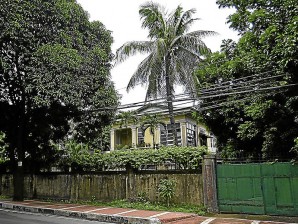QC gov’t acts to save house of founding father

HERITAGE FOR SALE This house of Commonwealth President Manuel L. Quezon on Gilmore Ave. in New Manila, Quezon City, is on sale and the QC government wants to buy and declare it a heritage site for a museum, the better to memorialize its significance not only to Quezon City but in the life of the nation. RAFFY LERMA
The government of Quezon City wants the house of its founding father declared as a heritage site.
It has made the request to the National Historical Commission of the Philippines (NHCP) following reports that President Manuel Luis Quezon’s heirs were planning on selling the 3,678-square-meter property where he lived while recovering from tuberculosis before World War II.
Quezon was the president during the Commonwealth era. Quezon City was established in 1939 and was named after him.
He briefly served as the city’s acting mayor in 1939 until Tomas Morato took over the post.
The sprawling property on Gilmore Avenue in Barangay (village) Mariana, New Manila, includes a two-story house, two one-story structures, quarters for servants and a swimming pool.
In the city government’s documents, the two-story house where Quezon lived was described as a colonial-type structure with five rooms built in the 1920s.
The city government learned of the purported plan to sell the property as early as 2008, during the term of Mayor (now House Speaker) Feliciano Belmonte Jr.
In an interview with the Inquirer, Belmonte said only three or four old houses remained in upper-middle-class New Manila.
“I really think the city government should move not only to declare [the Quezon property] a heritage site but also to acquire and preserve it,” Belmonte, a history buff, pointed out.
Cultural treasure
Quezon City planning and development officer Tomasito Cruz has written NHCP chairperson Maria Serena Diokno declaring the city government’s intention of registering the property as “an important cultural treasure.”
In a letter dated August 8, Cruz wrote: “It was brought to the attention of the city government that the Quezon-Avanceña property located along Gilmore Avenue is being offered for sale.
“May we therefore request your good agency [to tell us] the possible options on how to acquire subject property and declare it a heritage site in accordance with the National Cultural Heritage Act of 2009.”
The Inquirer tried to confirm the planned sale of the property with Quezon’s grandson, Enrique Quezon-Avanceña. But he responded in a text message: “The family has no comment on private family affairs.”
Former Inquirer columnist and now Palace Undersecretary Manuel Quezon III did not reply to inquiries by text message.
The city government itself has yet to receive official word from the family about the supposed planned sale.
“They haven’t officially told us. But the reports on the sale prompted us to act on it,” said Quezon City administrator Victor Endriga, citing real estate sources.
Prime property
A conservative estimate puts the value of the property at P110 million.
“I believe it could go beyond that figure because that area is prime property. The house has historical and cultural value to Quezon City and the entire country as well,” Endriga said in an interview.
He said the city government was “very worried about the proposed sale” of the precious landmark.
In documents furnished to the Inquirer, the property was described as occupying two lots and bounded by Gilmore Avenue and 7th and 8th Streets in Barangay Mariana.
The lots are registered to Zenaida “Nini” Quezon-Avanceña, the late President’s surviving daughter.
Avanceña, now in her 90s, lived in the house for 62 years. She has been living in Ayala Alabang since 2006.
The family had rented the house before buying it on installment, Avanceña said in an article run in the Inquirer in September 2008. She said the family had come to consider it a “lucky” house.
A caretaker now looks after the property that also includes a Japanese tea house, a gazebo, a basketball court and a guard house, according to Greg Banacia, chief of Quezon City’s Public Affairs Information and Service Office.
Inspection in 2008
Endriga recalled that Belmonte commissioned an inspection of the property after reports of the planned sale first surfaced. The inspection was conducted in the presence of a Quezon grandson.
A 2008 report on the inspection stated that the swimming pool was “nonfunctional but with new tiles installed,” and that the Japanese tea house was in fair condition.
A two-story structure built in the 1970s, which was used as office and storage space, and a one-story recreational hall, which served as a multipurpose hall, were among the renovations, the report said.
Endriga said the city government wanted to convert the property into a museum dedicated to the late President.
“That property has such a great historical significance that it would be a waste to let it go,” he said.
The city government is willing to buy the property, either on its own or with the NHCP, Endriga said.
Under the law, a property declared as a heritage site will receive funding for its conservation and restoration and will be maintained by the local government unit exercising jurisdiction over it.
Once the property becomes a heritage site, it cannot be sold without the NHCP’s permission, Endriga said.
History
According to Endriga, private developers have expressed interest in the property, which stands in an area where rows of townhouses are being developed.
“That property is priceless because it stands for the cultural heritage of our history. What will happen to our children if they no longer know who Quezon is, years from now?” Endriga said.